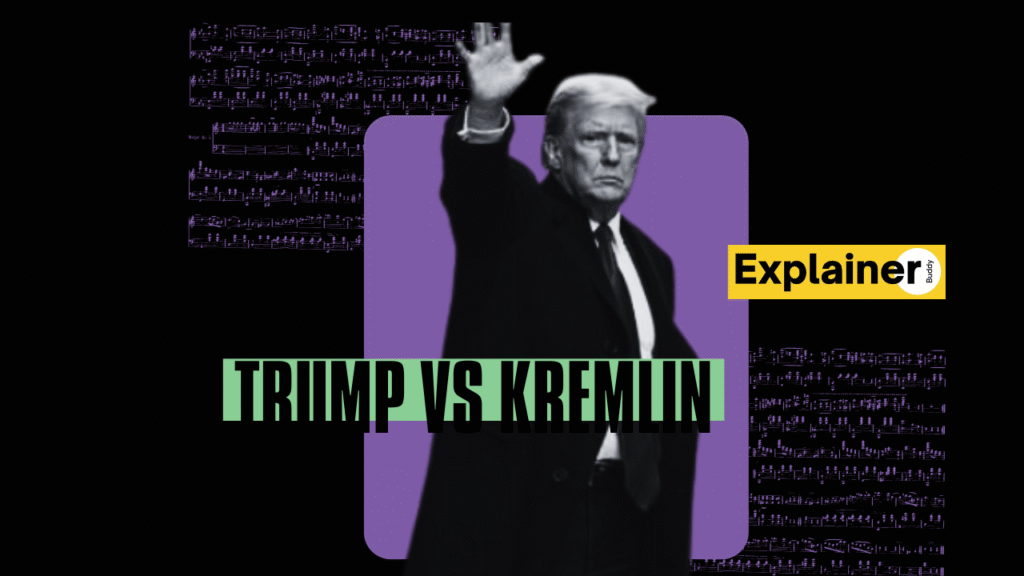How Donald Trump’s shifting stance on Putin, Ukraine, and sanctions is playing out in Kremlin propaganda and global diplomacy.
When U.S. President Donald Trump called Vladimir Putin “absolutely CRAZY” following Russia’s most devastating aerial attack on Ukraine, political observers worldwide were left stunned. It was one of Trump’s harshest public criticisms of Putin—marking a sharp contrast from his previous tone, often criticized as too soft on the Kremlin. But while these remarks captured headlines, the real story lies deeper—in the Kremlin’s calculated response, Trump’s mixed record, and how Russian media spins the narrative to their advantage.
This isn’t just about fiery words between two powerful men—it’s about global consequences. In a world reeling from the ongoing Russia-Ukraine war, Trump’s statements hold diplomatic weight. But his unpredictability and conflicting messages have cast doubt on the West’s unity, and more importantly, its ability to deter Russia’s military aggression.
In this, we explore the entire saga—from Trump’s recent rebuke of Putin, his criticism of Zelenskyy, the response from Russian media, and how this plays into broader international politics. With each twist, this story reveals not only the instability of current geopolitics but also the media manipulation used to maintain power and sway public opinion.
Trump, Putin, and the Ukraine Conflict
Trump’s relationship with Vladimir Putin has always been controversial. During his presidency, Trump often praised Putin’s leadership style, creating waves among allies and political critics. Despite intelligence reports pointing to Russian interference in the 2016 U.S. election, Trump repeatedly avoided direct condemnation of the Kremlin.
Even during the early stages of the Ukraine war, Trump refrained from taking a strong stance. He boasted that the war would never have happened under his leadership, framing himself as a potential peacemaker. Meanwhile, his administration’s policy toward Ukraine was riddled with inconsistencies—from briefly holding back military aid to making backchannel requests through personal lawyer Rudy Giuliani.
Understanding this context is crucial: Trump’s latest condemnation of Putin didn’t emerge in a vacuum—it came after years of a relationship marked by mixed messages, personal diplomacy, and transactional politics.
From Harsh Words to Political Theatre
After Russia’s massive drone and missile strike that killed over a dozen people in Ukraine, Trump made rare and aggressive comments. “I don’t know what the hell happened to Putin,” he said on Truth Social. He warned that continued aggression could “lead to Russia’s demise,” further stating Putin wanted “ALL of Ukraine.” While these remarks seemed to represent a significant policy shift, Trump’s record tells a different story. He has historically resisted efforts by the EU and NATO to impose tough sanctions, often pushing back on increases in military support for Kyiv.
Trump didn’t stop at Putin. He also criticized Ukrainian President Volodymyr Zelenskyy, claiming that his rhetoric “creates problems” and urging him to tone it down. This drew backlash, particularly from Ukrainian officials who saw it as undermining their leadership during a crisis.
The Kremlin wasted no time spinning the narrative. Spokesperson Dmitry Peskov dismissed Trump’s words as “emotional overload” and expressed “gratitude” for Trump’s previous diplomatic efforts. Russian state media reinforced this image—portraying Trump as a passionate but pragmatic player who could still be a valuable partner. This is classic propaganda strategy: disarm criticism by reframing it as irrational, while quietly reinforcing the image of Trump as someone open to negotiation.
Where Things Stand Now: Unpredictability and Propaganda
The situation has only grown murkier. Trump held a two-hour phone call with Putin, after which he abandoned calls for a U.S.-imposed ceasefire, instead urging Ukraine and Russia to handle it themselves. This flip-flop left European diplomats and NATO allies frustrated and skeptical of America’s future role in the conflict.
Ukraine accepted a proposed 30-day ceasefire brokered by the U.S., but Putin rejected it outright—continuing aerial strikes across multiple cities. Trump’s stance has not only emboldened Russia by signaling a lack of unified Western resolve but also demoralized Kyiv, which views American support as critical to survival.
Trump’s oscillating policies—and Russian media’s clever spin on his comments—have far-reaching implications:
- Diplomatic Paralysis: Western allies find it harder to form a unified strategy when Trump’s positions fluctuate.
- Propaganda Opportunity: The Kremlin uses Trump’s mixed messages to sow doubt, portraying Western democracies as divided and ineffective.
- Future Elections: Trump’s rhetoric will play a significant role in the 2024 U.S. elections, especially as foreign policy becomes a key debate topic.
Ultimately, this dynamic shows how emotional language and strategic ambiguity can shape international relations more than formal policy. Russia’s state media machinery is adept at neutralizing criticism while weaponizing division. Trump’s evolving relationship with Russian media and the Kremlin reflects a broader crisis in global diplomacy. On the surface, he may appear to be rebuking Putin, but his actions—and lack of consistent follow-through—speak otherwise. For Ukraine and the West, this creates confusion, delays effective action, and ultimately gives Russia more room to maneuver.
The Kremlin, meanwhile, continues to manipulate narratives for its own benefit—portraying Trump as both emotional and cooperative, unpredictable yet useful. This blend of media strategy, political theater, and conflicting foreign policy has made the conflict even more intractable. The real danger? When political drama overshadows unified action, the victims are always those on the front lines—in this case, the people of Ukraine.





















